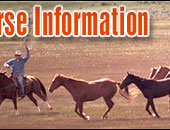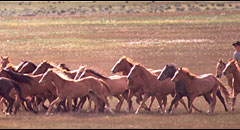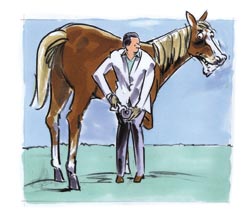 |
   |
|
|
|
You are here: Horses > Horse health > Navicular Disease |
Navicular Horse Disease - Is it over diagnosed in equines?
Characterized by gradually increasing intermittent lameness often of both front
feet, navicular disease is one diagnosis no horse owner wants to hear. This
disease is often associated with hard work, and is incurable.
|
|
|
Affected horses will shorten their stride, most
noticeably when going downhill, and can be reluctant to turn. Sometimes the
lameness can seem to 'switch' from one side to the other. This is due to the
disease affecting both front feet to different degrees. However, some
veterinarians feel that navicular disease (or as it is sometimes called, navicular syndrome)
is overdiagnosed. Knowing more can help you decide what to do if your horse is
diagnosed with navicular disease. |
 First of all, what is navicular disease? This disorder is caused by a gradual
deterioration of the navicular bone at the back of the horse's foot, near the
heel. Some veterinarians will diagnose navicular syndrome, using the term to
broadly include all the soft tissue surrounding the navicular bone. First of all, what is navicular disease? This disorder is caused by a gradual
deterioration of the navicular bone at the back of the horse's foot, near the
heel. Some veterinarians will diagnose navicular syndrome, using the term to
broadly include all the soft tissue surrounding the navicular bone.
Veterinarians aren't sure exactly what causes the bone to deteriorate, but most
feel that navicular disease is a degenerative condition like arthritis.
Frequently, navicular disease strikes horses that perform hard work, often on
hard surfaces. Once thought to be an extremely common condition, many
veterinarians now think that it is less common than was once believed.
Foot problems are the leading cause of lameness. However, before accepting a
diagnosis of navicular disease, there are other factors that the veterinarian
should consider.
While there are certain people who believe the shape of the hoof can indicate
that a horse is at greater risk for navicular disease--such as horses with
upright, small hooves, or horses with large, platter-like hooves--there is not
much evidence that hoof shape is a very important risk factor. However, some
risk factors are proven, such as performance horses that spend more time running
hard, and in whom the condition is most bothersome. Also, age is a factor, with
navicular disease most often striking horses between seven and eleven years of
age.
The signs of true navicular disease can be identical with those of sore heels,
which can complicate the diagnostic process. "Pointing," which refers to a horse
standing with its front feet far in front of its body, is a common symptom of
both navicular disease and sore or bruised heels. Also, riders may notice the
horse is reluctant to turn, another shared symptom.
Many diseases can mimic navicular disease besides sore or bruised heels. Chronic
heel collapse is another, as is a torn deep flexor tendon at the point where it
inserts into the coffin bone. Simple stress and strain from overwork can result
in a horse showing the symptoms of navicular disease. The soft tissues around
the navicular bone can also be strained, such as the impar ligament or the
suspensory ligaments surrounding the bone. The coffin joint can also become
inflamed. The list is long and this is not a complete list of things which share
the symptoms of navicular disease, which is why it is important that the
veterinarian not jump to this diagnosis without more tests.
No one test can definitively diagnose true navicular disease. A diagnosis is
made by performing a series of tests--hoof tests, nerve blocks, x-rays, stress
tests, bone scans--and reviewing all the results to find the most likely cause
of the horse's lameness. Studies are progressing regarding the use of ultrasound
or MRI to help veterinarians to determine what is going on inside the foot.
Many veterinarians will not diagnose navicular disease until the horse has
failed to respond to any treatment for at least ninety days. Keeping all this in
mind might help if your veterinarian diagnoses navicular disease after only a
cursory examination.
In the case of true navicular disease, caused by the deterioration of the
horse's navicular bone, there is no cure. However, horses affected by navicular
disease can be made more comfortable in a variety of ways. New shoeing and
trimming techniques can relieve stress on the bone, and pain-relieving and
anti-inflammatory medications can also help. In horses that are more severely
affected, the only effective treatment may be to remove the nerves to the area
via a surgical neurectomy. While this does give relief from the heel pain, it is
only a temporary solution.
Surgical neurectomies can produce occasional side effects. Most commonly (but
still only rarely seen) are neuromas. These painful lumps are caused when the
ends of the severed nerves grow back together in a large ball, forming a lump
which can be felt under the skin. Very rarely, a horse may experience a
complication which could necessitate the amputation of the foot, but this is
extremely uncommon.
More commonly, horses will have bad results if they receive a neurectomy when
they do not have true navicular disease. For example, if the horse's lameness is
due to a deep flexor tendon problem rather than the navicular bone, the horse
can severely damage that tendon because it will be unable to feel the pain from
the injury.
If your veterinarian diagnoses navicular disease, it is therefore prudent to
seek a second opinion. Presenting a second veterinarian with the films from the
bone scan and x-rays can allow him to give an opinion without putting your
horse--and your wallet!--through another round of tests. Taking the time to do
this can prevent a costly and painful misdiagnosis.
 |
Read the next horse health tips article on Stomach Problems & Ulcers. |
|
|
|
|
 |
|
|
|
|
|
Horse Education
|
|
|
|
|
Horse Information Topics
|
|
|
|
|
|
|
|
Horse Business Owners
|
| |
Advertise with Us
Have your horse products or services exposed to over 27,000 of our monthly visitors.
|
|
|
|
|
|